Electric Vehicles Charged with Solar-PV: A Brazilian Case Study for 2030
Abstract
:1. Introduction
2. Materials and Methods
2.1. Estimate the Flow of EVs on the Fernão Dias Highway for 2030
- Because the highway is an interstate, the EVs from the states of São Paulo and Minas Gerais that circulate on the highway were considered, with an additional safety margin of 10% for vehicle traffic from other states. The percentage of circulating vehicles from these two states was obtained from [22].
- The share of EVs circulating in each scenario for 2030 was applied to the projected daily flow of traffic on the highway.
- The monthly traffic flows available in [26] were divided by the number of days in each month to determine daily traffic flows.
2.2. Estimate the Number of EV Charging Stations Needed along the Highway
2.3. Project the PPSs Needed to Meet the Demand of the Charging Stations
- Service areas located in the same city are to be supplied by PPSs in the same coverage area as the local electric energy concessionaire;
- The PPSs are to be sized to completely meet annual demand for electric energy at the charging stations in order to minimize the costs of recharging EVs;
- Installation of photovoltaic modules on the ground, in unlimited sheds, with azimuth equal to 0° and inclination equal to the latitude of the installation site;
- Distance between sheds to prevent shading from 8 am to 4 pm at any time of the year;
- Panels assembled with free air circulation;
- Thermal losses in the DC circuit are 1.50% at Standard Test Conditions (STC), and voltage drops in the 0.7 V series of diodes.
2.4. GHG Emissions
- Ep is the annual rate of pollutant emissions considering t/year;
- Frji is the number of vehicles with fuel source j that pass through toll booth i;
- Fej is the pollutant emissions factor (gpollutant/km) for vehicles with fuel source j;
- d is the distance driven by the vehicles in circulation to toll booth i.
3. Results and Discussions
4. Conclusions
Author Contributions
Funding
Data Availability Statement
Acknowledgments
Conflicts of Interest
Nomenclature
| Vt | total number of vehicles per capita at time t; |
| γi | saturation level, in terms of vehicles per one thousand inhabitants, in country i; |
| θ | adjustment speed of vehicle growth according to growth in income, where 0 < < 1; |
| α | parameter that determines the value in the Gompertz function for lower-level income classes; |
| β | parameter that corresponds to the level of income in each county at which the maximum saturation level γmax for 831 vehicles for 1.00 habitants is reached |
| F(t) | accumulated fraction of the market potential that adopts the product by time t; |
| p | innovation coefficient; |
| q | imitation coefficient. |
| m | projection factor for annual traffic; |
| Tri | annual traffic per toll station at year i; |
| Fci | total number of vehicles in circulation in year i; |
| Trpj | annual traffic projected for each toll station in year j; |
| Fcpj | total number of vehicles in circulation in year j. |
| dpq | distance between two service areas p and q in km; |
| ρa | autonomous anxiety factor; |
| rv | autonomous range of the vehicle in km; |
| χp | number of charging stations; |
| αl | amplification factor; |
| γ | number of recharging connectors; |
| fl | average flow of vehicles at the link l (vehicles/day); |
| Np | number of EVs that can be directly recharged at each connector at the charging station; |
| frl | maximum flow of vehicles at the link l in the reference period; |
| fml | average flow of vehicles at the link l in the reference period; |
| ϕd | duration of the day in hours; |
| Pstation | potential of the charging station in kW; |
| Eav | energy of the battery system of the vehicle in kWh; |
| E | annual pollutant rate per year considering (g/year); |
| Fe | pollutant emission factor considering (gpollutant/km); |
| Fr | number of vehicles in circulation; |
| Iu | use intensity of the vehicle in km/year; |
| Ear | the avoided CO2 emissions by recharging EVs using PPSs (CO2/year); |
| Ege | emissions rate for CO2 in the Brazilian energy matrix (t CO2/MWh); |
| Ecsa | consumed energy from recharging EVs per service area (MWh/day). |
References
- Pablo, J.M.S.; de López, M.M.; Bret, A. How Green Are Electric or Hydrogen-Powered Cars? Assessing GHG Emissions of Traffic in Spain, 1st ed.; Springer: Berlin/Heidelberg, Germany, 2016; ISBN 10: 3319324330. [Google Scholar]
- IEA. Key World Energy Statistics—2019. Encycl. Ecol. 2018, 4, 50–63. [Google Scholar] [CrossRef]
- EPE. Empresa de Pesquisas Energeticas. Energetic National Balance 2019. Report Base Year 2018–2019:67. Available online: https://www.epe.gov.br/pt/publicacoes-dados-abertos/publicacoes/balanco-energetico-nacional-2019 (accessed on 3 June 2020).
- European Commission. Transport Emissions. A Eur Strateg Low-Emission Mobil 2016. Available online: https://ec.europa.eu/clima/policies/transport_en#tab-0-0 (accessed on 3 June 2020).
- Şahin, M.E. A photovoltaic powered electrolysis converter system with maximum power point tracking control. Int. J. Hydrog. Energy 2020, 45, 9293–9304. [Google Scholar] [CrossRef]
- Arroyo, V.; Holsinger, H.; Wolosin, M.; Linquiti, P.; Ahmad, S.; Adkins, L. Policies to Reduce Emissions from the Transportation Sector. Congr Policy Briefs Ser 2008. Available online: https://www.c2es.org/document/policies-to-reduce-emissions-from-the-transportation-sector/ (accessed on 3 June 2020.).
- Suski, A.; Remy, T.; Chattopadhyay, D.; Song, C.S.; Jaques, I.; Keskes, T.; Li, Y. Analyzing Electric Vehicle Load Impact on Power Systems: Modeling Analysis and a Case Study for Maldives. IEEE Access 2021, 9, 125640–125657. [Google Scholar] [CrossRef]
- ABVE. Government Announces Rota 2030 and Cuts IPI for Electrics 2018. Available online: http://www.abve.org.br/governo-anuncia-rota-2030-e-corta-ipi-para-eletricos/ (accessed on 3 June 2020).
- Albuquerque, F. EDP Announces Ultrafast Charging Network for Electric Vehicles 2019. Available online: https://agenciabrasil.ebc.com.br/economia/noticia/2019-10/edp-anuncia-rede-de-recarga-ultrarrapida-de-veiculos-eletricos (accessed on 29 May 2020).
- ABVE. Electric Mobility Brasil Installs Electrified Highway on Dutra 2018. Available online: http://www.abve.org.br/electric-mobility-instala-eletrovia-na-dutra/ (accessed on 28 April 2020).
- ARTERIS S/A. Fernão Dias 2020. Available online: https://www.arteris.com.br/rodovias/fernao-dias/ (accessed on 10 April 2020).
- Ministry of the Environment. National Inventory of Atmospheric Emissions from Road Motor Vehicles—2013. Brasília: 2014. Available online: http://anuario.antt.gov.br/index.php/content/view/5632/1__Inventario_Nacional_de_Emissoes_Atmosfericas_por_Veiculos_Automotores_Rodoviarios.html (accessed on 4 June 2020.).
- Sørensen, A.L.; Sartori, I.; Lindberg, K.B.; Andresen, I. A method for generating complete EV charging datasets and analysis of residential charging behaviour in a large Norwegian case study. Sustain. Energy Grids Netw. 2023, 36, 101195. [Google Scholar] [CrossRef]
- Rahman, S.; Khan, I.A.; Khan, A.A.; Mallik, A.; Nadeem, M.F. Comprehensive review & impact analysis of integrating projected electric vehicle charging load to the existing low voltage distribution system. Renew. Sustain. Energy Rev. 2021, 153, 111756. [Google Scholar] [CrossRef]
- Kim, J.; Oh, H.; Lee, J. Data-driven cost-effective capacity provisioning scheme in electric vehicle charging facility. Comput. Ind. Eng. 2022, 173, 108743. [Google Scholar] [CrossRef]
- Baran, R.; Legey, L.F.L. The introduction of electric vehicles in Brazil: Impacts on oil and electricity consumption. Technol Forecast. Soc. Chang. 2013, 80, 907–917. [Google Scholar] [CrossRef]
- Dargay, J.; Gately, D.; Sommer, M. Vehicle ownership and income growth, worldwide: 1960–2030. Energy J. 2007, 28, 143–170. [Google Scholar] [CrossRef]
- IBGE. Cidades@ 2020. Available online: https://cidades.ibge.gov.br/ (accessed on 14 April 2020).
- The World Bank. GDP per Capita (Constant 2010 US$)—Brazil. World Bank Gr—Int Dev Poverty, Sustain n.d. Available online: https://data.worldbank.org/indicator/NY.GDP.PCAP.KD?end=2018&locations=BR&start=1990&view=chart (accessed on 28 February 2020).
- EPE. Economic Scenario for the Next Ten Years (2020–2029). Rio de Janeiro: 2019. Available online: https://www.epe.gov.br/sites-pt/publicacoes-dados-abertos/publicacoes/PublicacoesArquivos/publicacao-440/NT%20Cen%C3%A1rio%20Econ%C3%B4mico%2010%20anos%202029%20VF.pdf (accessed on 15 July 2020).
- Sindipeças. Rolling Fleet Report—2019 Edition. São Paulo: 2019. Available online: https://www.josepauloecon.com/wp-content/uploads/2020/06/R_FrotaCirculante_2019.pdf?x35660 (accessed on 10 July 2020).
- Bass, F.M. A new product growth for model consumer durables. Manag. Sci. 1969, 15, 215–227. [Google Scholar] [CrossRef]
- ANFAVEA. Brazilian Automotive Industry Yearbook 2019. São Paulo: 2019. Available online: https://anfavea.com.br/anuario2019/anuario.pdf (accessed on 10 July 2020).
- Maxton. Brazil’s Main Highways 2018. Available online: https://maxtonlogistica.com.br/as-principais-rodovias-do-brasil/ (accessed on 10 April 2020).
- ANTT. Agencia Nacional de Transporte Terrestre Real Flow of Paying Vehicles. Brasília: 2020. Available online: https://www.sindipecas.org.br/area-atuacao/?co=s&a=frota-circulante (accessed on 10 July 2020).
- Napoli, G.; Polimeni, A.; Micari, S.; Andaloro, L.; Antonucci, V. Optimal allocation of electric vehicle charging stations in a highway network: Part 1. Methodology and test application. J. Energy Storage 2020, 27, 101102. [Google Scholar] [CrossRef]
- Martins, J.; Brito, F.P.; Pedrosa, D.; Monteiro, V.; João, L. Real-Life Comparison Between Diesel and Electric Car Energy Consumption. In Grid Electrified Vehicles Performance, Design and Environmental Impacts; Nova Science Publishers: New York, NY, USA, 2013; pp. 209–232. ISBN 978-1-62808-839-7. Available online: https://www.novapublishers.com/catalog/product_info.php?products_id=44945 (accessed on 10 July 2020).
- Franke, T.; Krems, J.F. Interacting with limited mobility resources: Psychological range levels in electric vehicle use. Transp. Res. Part A Policy Pract. 2013, 48, 109–122. [Google Scholar] [CrossRef]
- Soares LFRRM. Bandeirantes, JK and the Duplication that Took More than a Decade: Learn about the History of Fernão Dias. Asf—G1 Sul Minas 2018. Available online: https://g1.globo.com/mg/sul-de-minas/noticia/bandeirantes-jk-e-a-duplicacao-que-demorou-mais-de-uma-decada-conheca-a-historia-da-fernao-dias.ghtml (accessed on 12 June 2020).
- Electricmobility. EFACEC QC45 2020. Available online: http://electricmobilitybrasil.com/qc45/ (accessed on 28 April 2020).
- ANEEL. Normative Resolution N° 517, de 11 de Dezembro de 2012. Available online: https://www2.aneel.gov.br/cedoc/ren2012517.pdf (accessed on 2 May 2020).
- Silva, T.C.; Pinto, G.M.; de Souza, T.A.Z.; Valerio, V.; Silvério, N.M.; Coronado, C.J.R. Technical and economical evaluation of the photovoltaic system in Brazilian public buildings: A case study for peak and off-peak hours. Energy 2020, 190, 116282. [Google Scholar] [CrossRef]
- ENEL. ENEL Energy Tariff 2020. Available online: https://www.eneldistribuicaosp.com.br/corporativo-poder-publico/tarifa-de-energia-eletrica (accessed on 21 April 2020).
- CEMIG. Energy Tariff CEMIG 2020. Available online: https://www.cemig.com.br/pt-br/atendimento/corporativo/Paginas/tarifas.aspx (accessed on 21 April 2020).
- CEMIGAvailability Map 2020. Available online: https://geo.cemig.com.br/mca/Home/IndexData (accessed on 9 July 2020).
- European Commission. 2050 Long-Term Strategy 2020. Available online: https://ec.europa.eu/clima/policies/strategies/2050_en (accessed on 20 May 2020).
- Council of the European Union. Cutting Emissions: Council Adopts CO2 Standards for Trucks 2020. Available online: https://www.consilium.europa.eu/en/press/press-releases/2019/06/13/cutting-emissions-council-adopts-co2-standards-for-trucks/ (accessed on 20 May 2020).
- European Commission. Our Vision for A Clean Planet for All. 2018. Available online: https://ec.europa.eu/commission/presscorner/api/files/attachment/856608/2_LTS_IndustrialTransition.pdf (accessed on 3 May 2020).
- EV Compare. EV Compare. EVcompareIo/Cars 2020. Available online: https://evcompare.io (accessed on 20 May 2020).
- São Paulo State Government. São Paulo State Energy Yearbook 2019; Secretariat of Infrastructure and Environment: São Paulo, Brazil, 2019; Volume 53. [Google Scholar]
- EPE. Demand Scenarios for o PNE 2050. 2018. Available online: https://www.epe.gov.br/sites-pt/publicacoes-dados-abertos/publicacoes/PublicacoesArquivos/publicacao-227/topico-202/Cen%C3%A1rios%20de%20Demanda.pdf (accessed on 2 May 2020).
- CETESB. Vehicle Emissions in the State of São Paulo 2018. 2019. Available online: https://cetesb.sp.gov.br/veicular/#:~:text=O%20invent%C3%A1rio%20de%20emiss%C3%B5es%20veiculares,SO2%2C%20todos%20poluentes%20t%C3%B3xicos. (accessed on 10 June 2020).
- Dicionário Financeiro. O que é EBITDA? 2020. Available online: https://www.dicionariofinanceiro.com/ebitda/ (accessed on 27 May 2020).
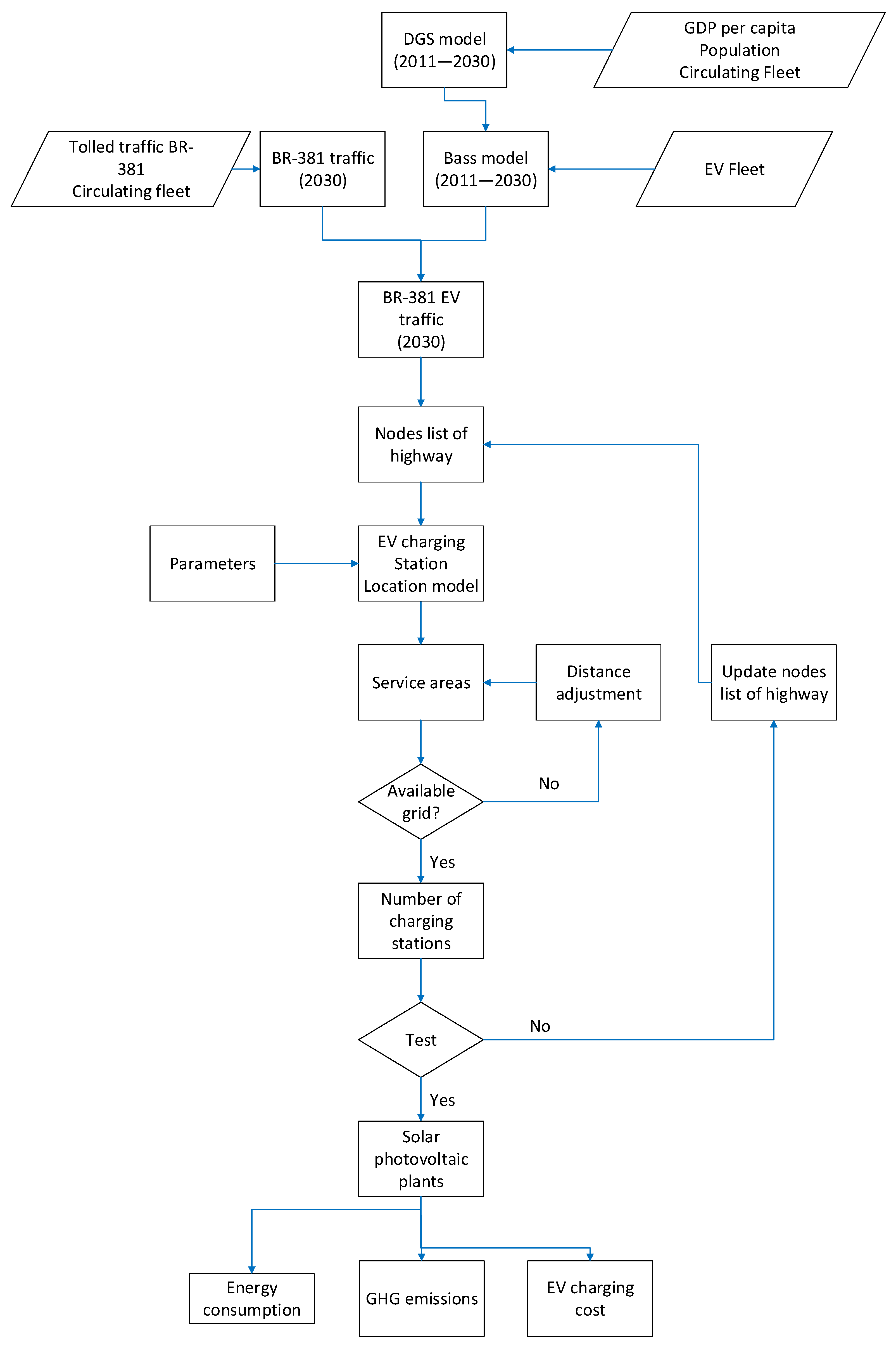
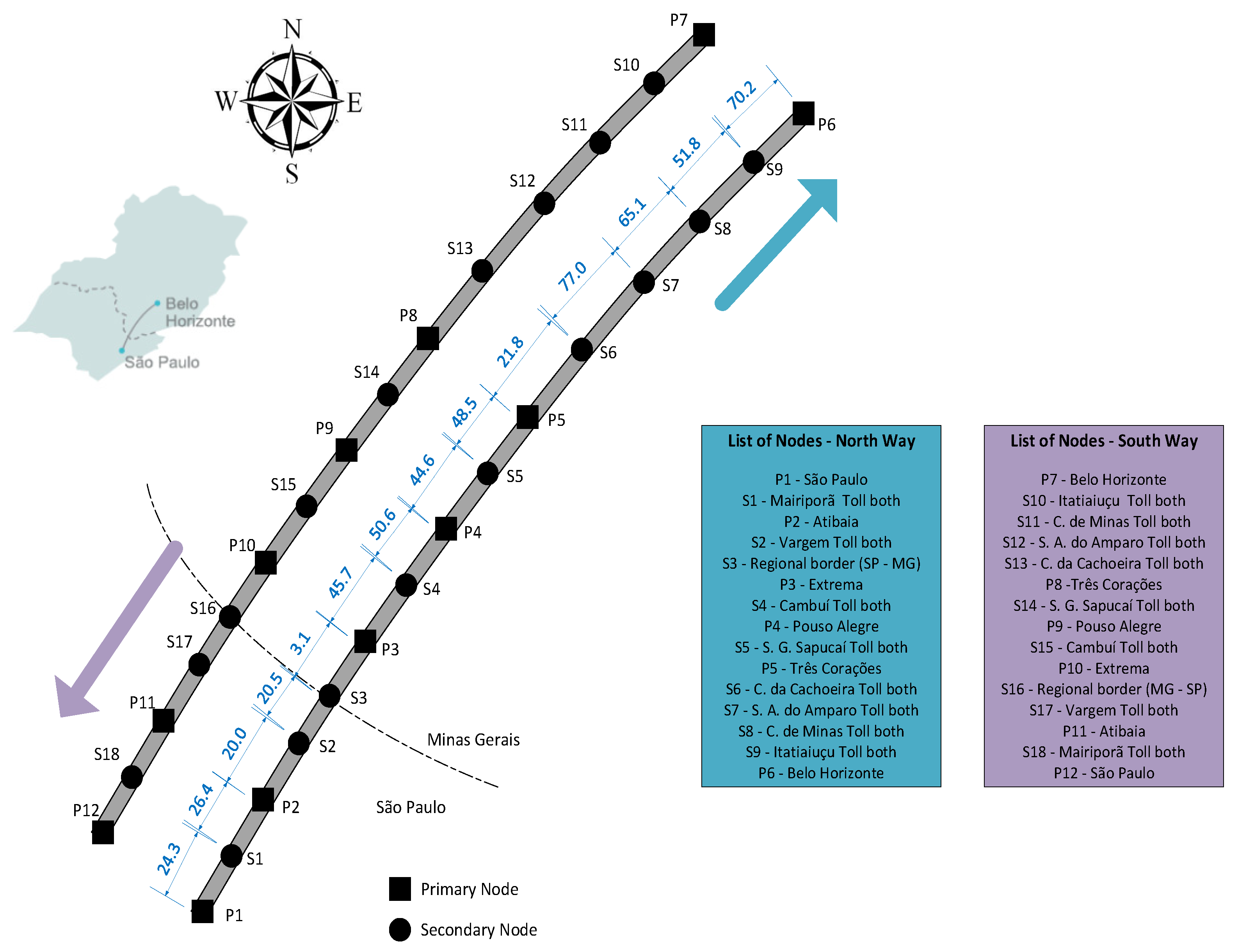
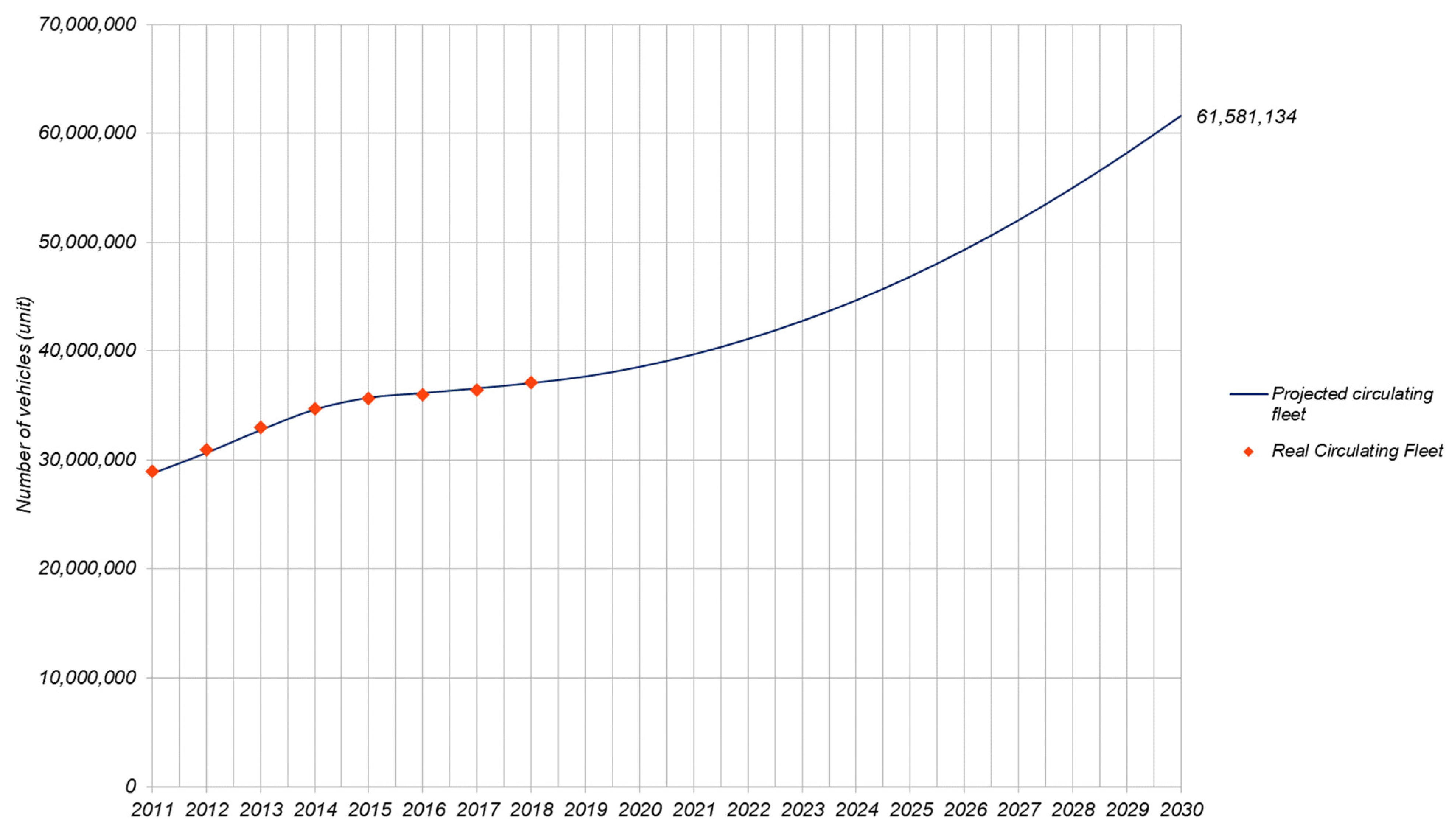
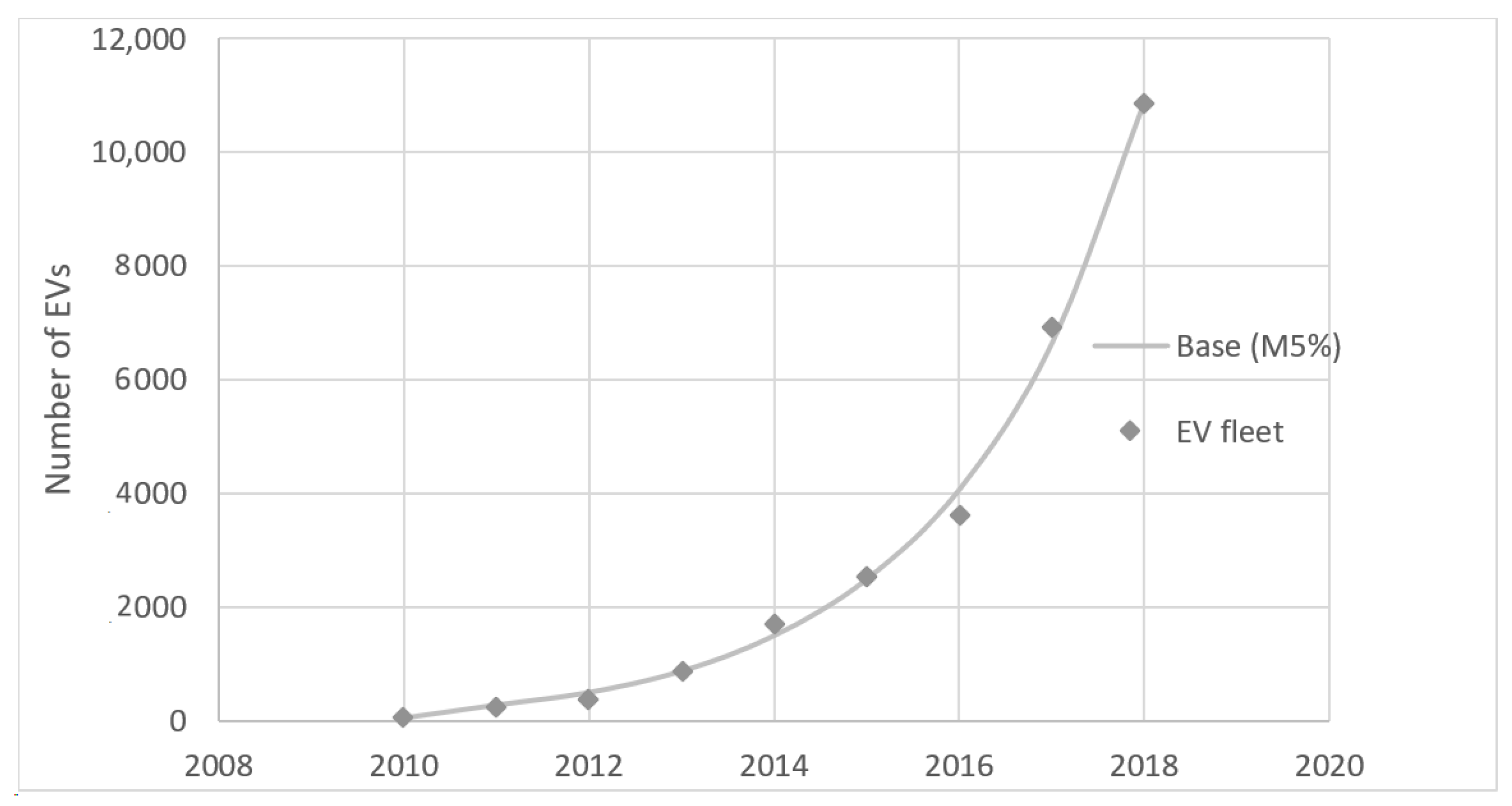
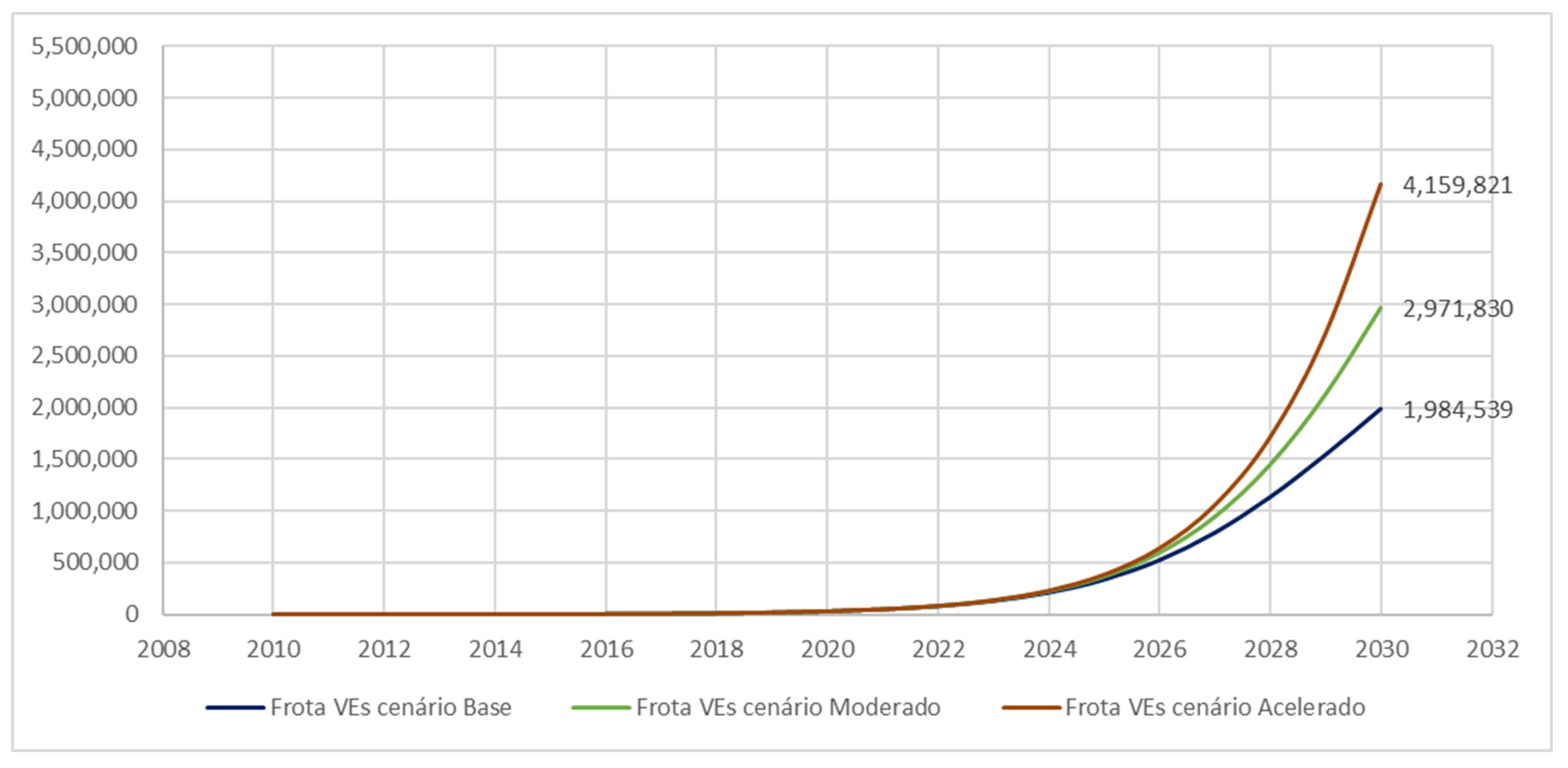
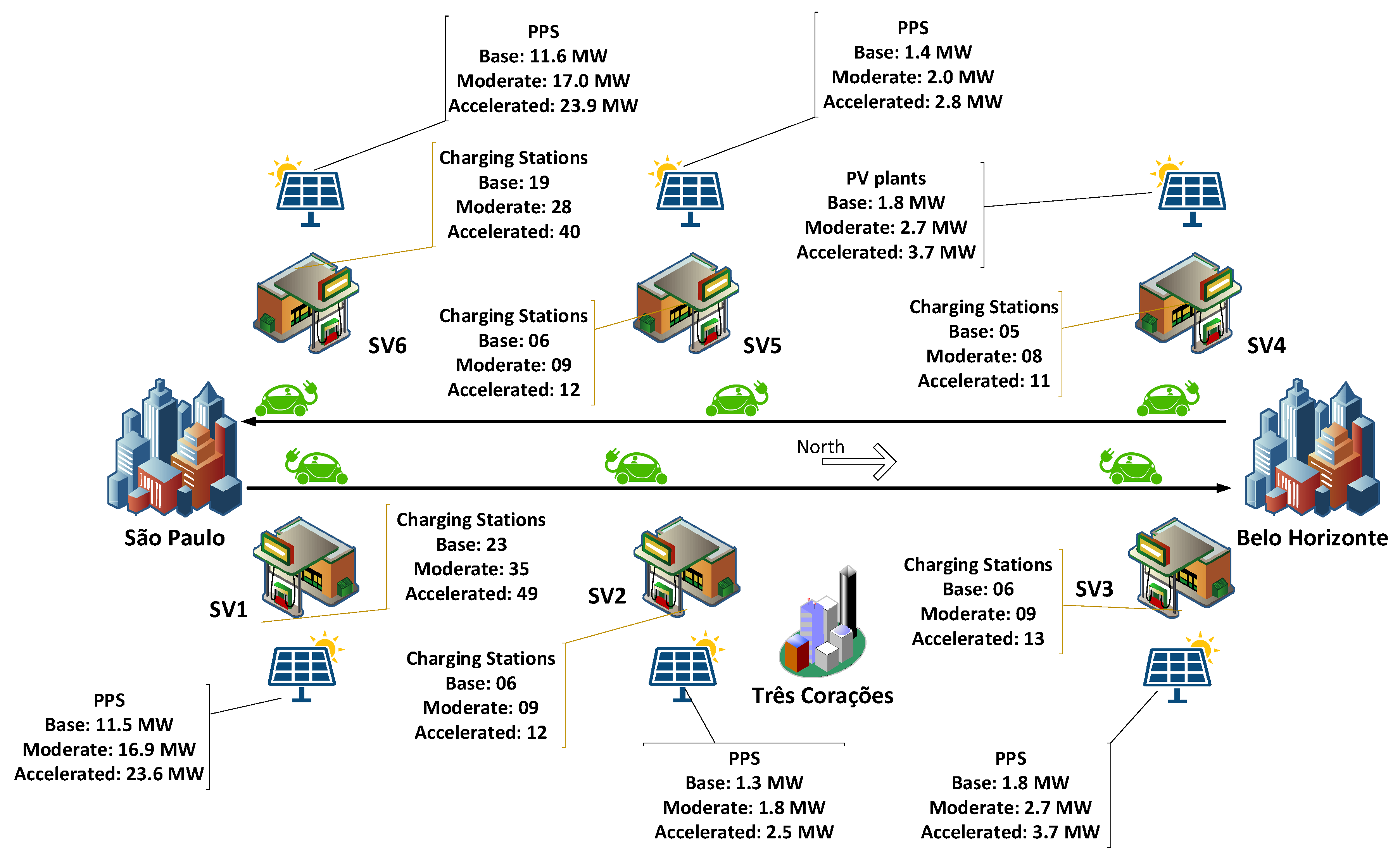
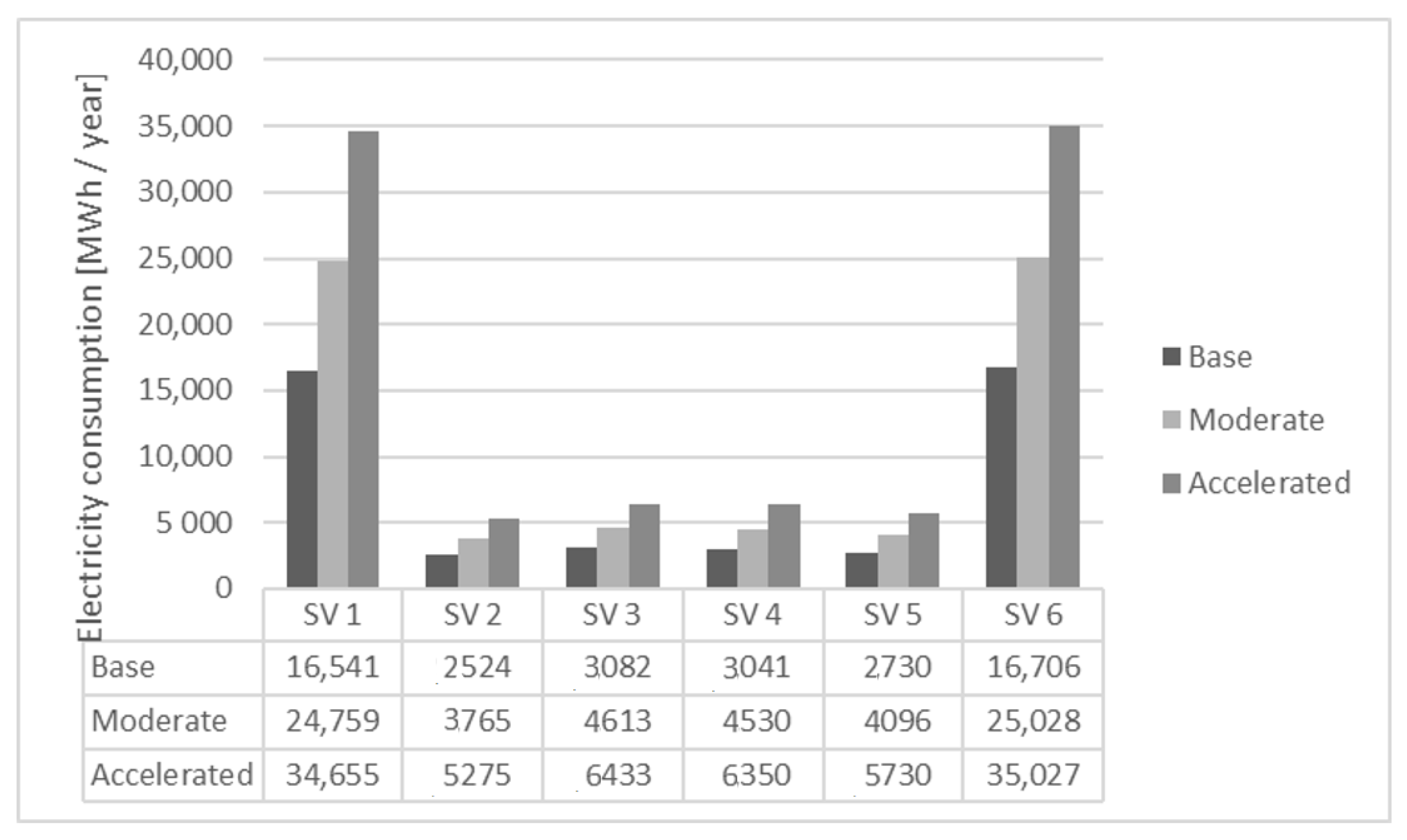
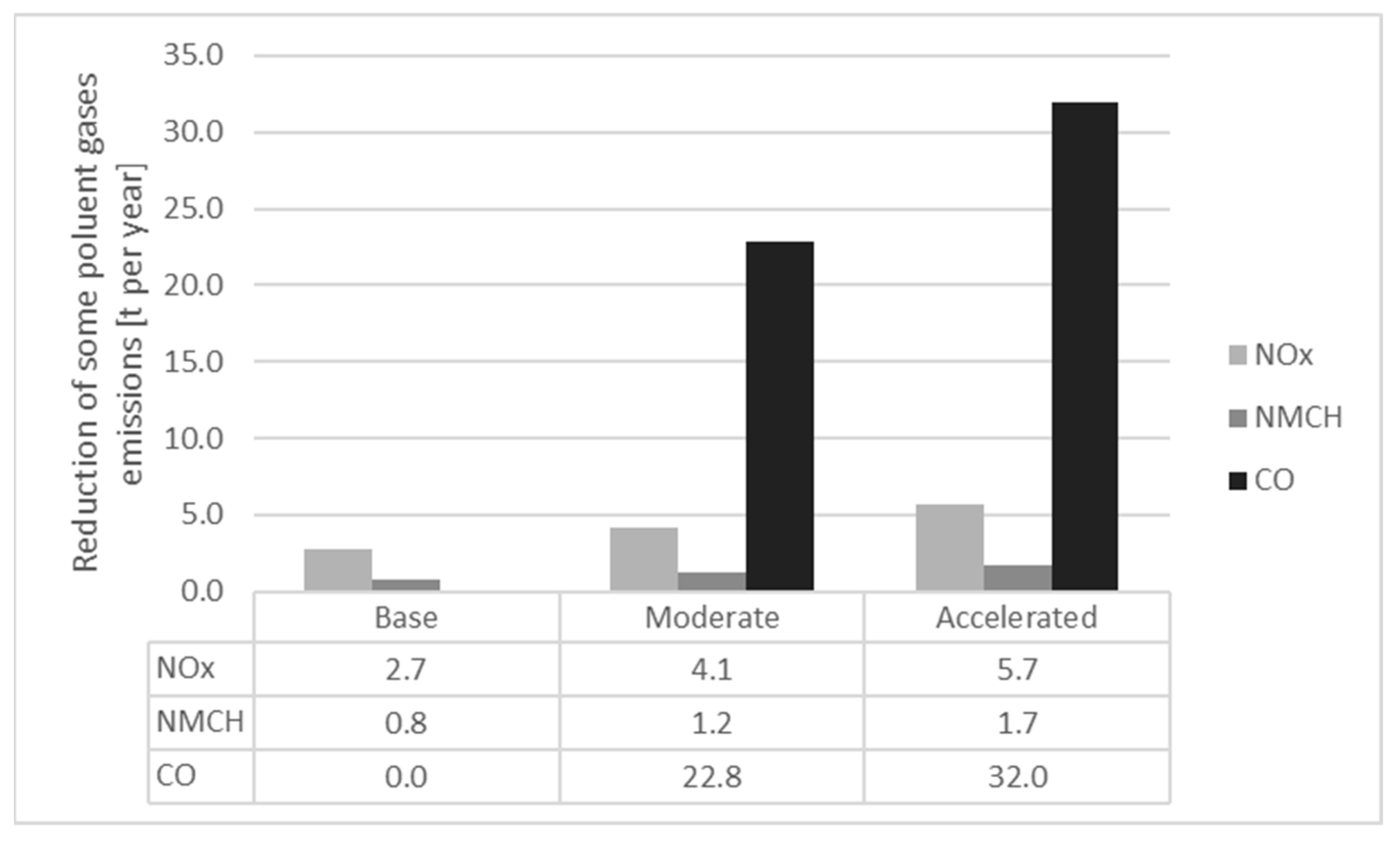
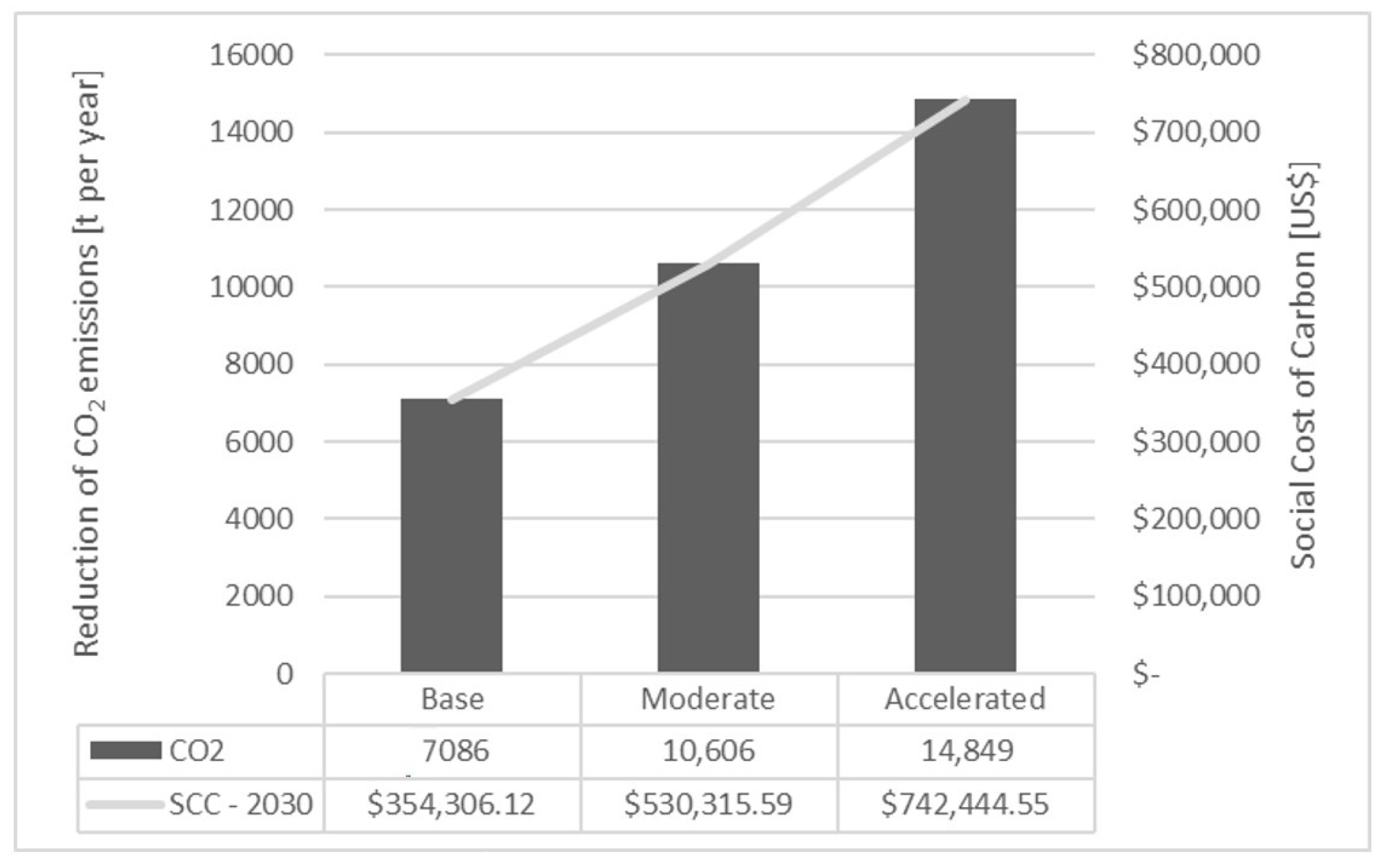
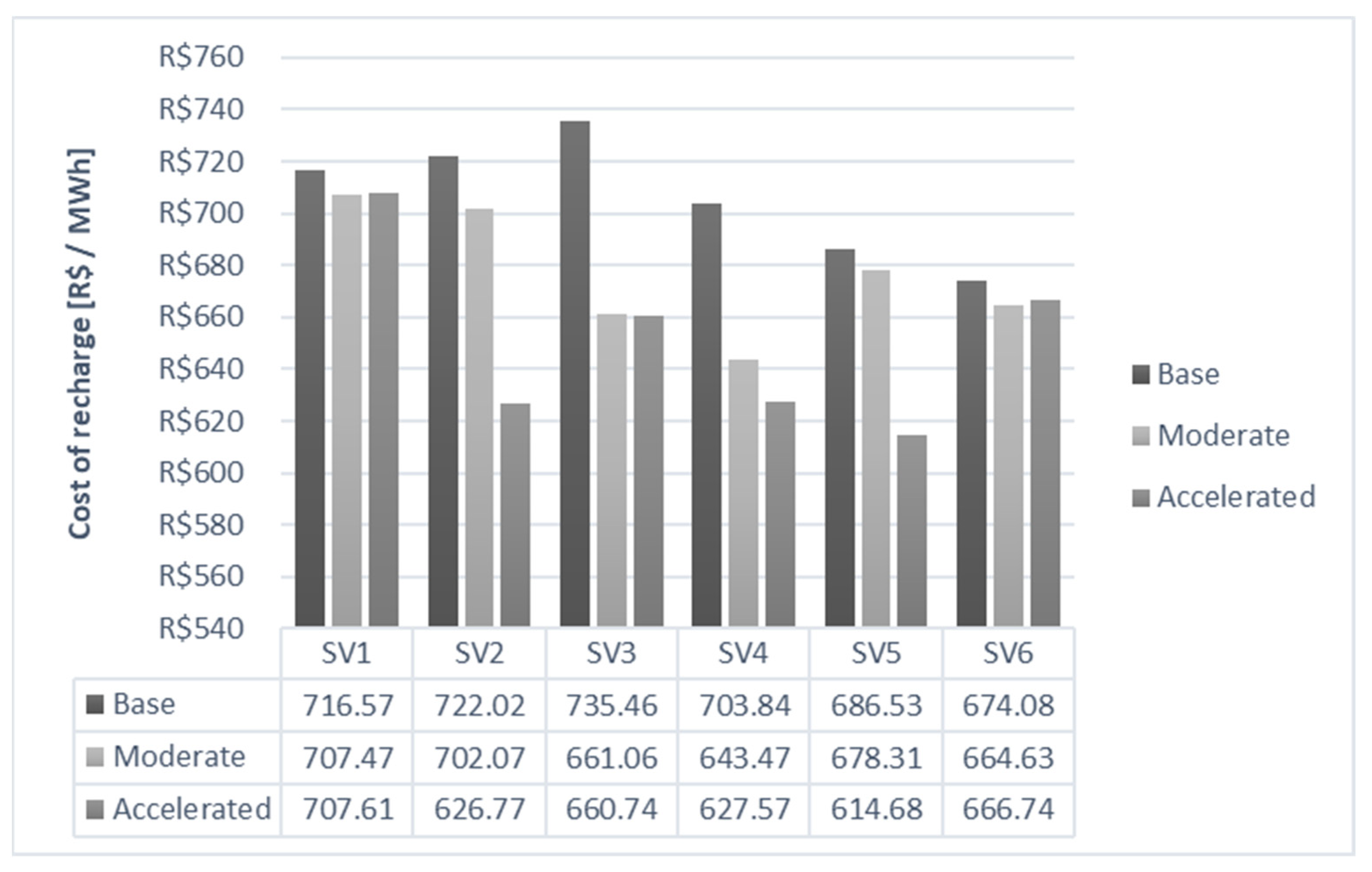
| Parameter | Amount |
|---|---|
| α | −18.85 |
| β | −0.23 |
| γ | 831 |
| θ | 0.095 |
| V0 | 137.9 |
| t0 | 2010 |
| Parameters | M5% | M10% | M25% |
|---|---|---|---|
| p | 0.00000573 | 0.00000278 | 0.00000112 |
| q | 0.477 | 0.479 | 0.479 |
| ID | Node | Way | Dist. (km) | Description | Charging Stations | ||
|---|---|---|---|---|---|---|---|
| Base | Mod. | Acc. | |||||
| SV 1 | P1 | North | 0 | São Paulo | 23 | 35 | 49 |
| SV 2 | P5 | North | 287.2 | Três Corações | 6 | 9 | 12 |
| SV 3 | P6 | North | 282.4 | Belo Horizonte | 6 | 9 | 13 |
| SV 4 | P7 | South | 0 | Belo Horizonte | 5 | 8 | 11 |
| SV 5 | P8 | South | 287.2 | Três Corações | 6 | 9 | 12 |
| SV 6 | P12 | South | 282.4 | São Paulo | 19 | 28 | 40 |
| Service Area | Location | Local Distributor | PPSs Power for Charging Stations (MW) | ||
|---|---|---|---|---|---|
| Base | Mod. | Acc. | |||
| SV 1 | São Paulo | ENEL | 11.5 | 16.9 | 23.6 |
| SV 2 | Três Corações | CEMIG | 1.3 | 1.8 | 2.5 |
| SV 3 | Belo Horizonte | CEMIG | 1.8 | 2.7 | 3.7 |
| SV 4 | Belo Horizonte | CEMIG | 1.8 | 2.7 | 3.7 |
| SV 5 | Três Corações | CEMIG | 1.4 | 2.0 | 2.8 |
| SV 6 | São Paulo | ENEL | 11.6 | 17.0 | 23.9 |
| North Way | Base | Moderate | Accelerated | ||||||
|---|---|---|---|---|---|---|---|---|---|
| Min | Ave | Max | Min | Ave | Max | Min | Ave | Max | |
| T1 | 272,655 | 291,635 | 344,925 | 408,435 | 436,540 | 516,475 | 571,955 | 611,010 | 723,065 |
| T2 | 104,755 | 116,800 | 156,220 | 156,950 | 174,835 | 233,965 | 219,730 | 244,915 | 327,405 |
| T3 | 65,700 | 75,190 | 107,310 | 98,550 | 112,785 | 160,965 | 137,605 | 158,045 | 225,205 |
| T4 | 37,960 | 44,530 | 67,160 | 56,575 | 66,430 | 100,740 | 79,205 | 93,075 | 140,890 |
| T5 | 41,245 | 49,275 | 74,460 | 61,685 | 73,365 | 111,325 | 86,505 | 102,930 | 155,855 |
| T6 | 36,500 | 42,705 | 65,335 | 54,385 | 64,240 | 97,820 | 76,285 | 89,790 | 137,240 |
| T7 | 37,230 | 43,800 | 65,700 | 55,845 | 65,700 | 98,550 | 78,110 | 91,980 | 137,605 |
| T8 | 47,085 | 54,385 | 76,285 | 70,445 | 81,395 | 113,880 | 98,550 | 113,515 | 159,505 |
| South Way | Base | Moderate | Accelerated | ||||||
| Min | Ave | Max | Min | Ave | Max | Min | Ave | Max | |
| T1 | 277,765 | 294,555 | 313,535 | 415,735 | 441,285 | 469,390 | 582,175 | 617,580 | 657,000 |
| T2 | 105,850 | 116,435 | 138,335 | 158,410 | 174,470 | 206,955 | 221,920 | 244,185 | 289,810 |
| T3 | 66,430 | 75,555 | 100,740 | 99,645 | 113,150 | 151,110 | 139,430 | 158,410 | 211,335 |
| T4 | 55,115 | 62,415 | 83,220 | 82,490 | 93,440 | 124,830 | 115,340 | 130,670 | 174,470 |
| T5 | 40,515 | 48,180 | 70,810 | 60,955 | 72,270 | 106,215 | 85,045 | 101,105 | 148,555 |
| T6 | 35,405 | 41,975 | 60,590 | 53,290 | 62,780 | 90,885 | 74,460 | 87,965 | 127,385 |
| T7 | 36,500 | 43,070 | 61,685 | 54,385 | 64,240 | 92,710 | 76,285 | 90,155 | 129,575 |
| T8 | 45,990 | 53,655 | 70,810 | 68,985 | 79,935 | 105,850 | 96,725 | 112,055 | 148,190 |
| Service Areas | Avoided CO2 Emissions by PVs (t CO2/Year) | ||
|---|---|---|---|
| Base | Moderate | Accelerated | |
| SV1 | 1376 | 2060 | 2883 |
| SV2 | 210 | 313 | 439 |
| SV3 | 257 | 384 | 536 |
| SV4 | 253 | 377 | 529 |
| SV5 | 227 | 341 | 477 |
| SV6 | 1390 | 2082 | 2914 |
| Indicator | Scenario | SV1 | SV2 | SV3 | SV4 | SV5 | SV6 |
|---|---|---|---|---|---|---|---|
| CAPEX | Base | BRL 3,729,553.88 | BRL 6,355,152.00 | BRL 8,497,152.00 | BRL 8,325,820.00 | BRL 6,563,784.00 | BRL 51,396,148.00 |
| Mod. | BRL 9,382,364.60 | BRL 9,150,228.00 | BRL 12,516,228.00 | BRL 12,298,536.00 | BRL 9,762,228.00 | BRL 75,455,376.00 | |
| Acc. | BRL 110,727,310.44 | BRL 12,557,304.00 | BRL 17,211,996.00 | BRL 16,776,612.00 | BRL 13,781,304.00 | BRL 105,947,680.00 | |
| OPEX | Base | BRL 4,429,311.20 | BRL 920,293.20 | BRL 1,070,618.11 | BRL 972,709.57 | BRL 943,563.06 | BRL 4,164,968.35 |
| Mod. | BRL 6,548,799.84 | BRL 1,343,560.66 | BRL 1,303,795.36 | BRL 1,204,362.79 | BRL 1,394,047.96 | BRL 6,210,432.35 | |
| Acc. | BRL 9,218,761.98 | BRL 1,540,823.43 | BRL 1,846,944.96 | BRL 1,651,303,16 | BRL 1,590,696.72 | BRL 8,717,699.43 | |
| EBITDA margin | Base | 60.4% | 46.5% | 49.9% | 51.8% | 46.6% | 60.8% |
| Mod. | 60.4% | 46.1% | 54.7% | 56.2% | 46.8% | 60.4% | |
| Acc. | 60.2% | 50.6% | 53.9% | 56.1% | 52.1% | 60.4% |
Disclaimer/Publisher’s Note: The statements, opinions and data contained in all publications are solely those of the individual author(s) and contributor(s) and not of MDPI and/or the editor(s). MDPI and/or the editor(s) disclaim responsibility for any injury to people or property resulting from any ideas, methods, instructions or products referred to in the content. |
© 2023 by the authors. Licensee MDPI, Basel, Switzerland. This article is an open access article distributed under the terms and conditions of the Creative Commons Attribution (CC BY) license (https://creativecommons.org/licenses/by/4.0/).
Share and Cite
Costa, D.d.; Cobas, V.R.M. Electric Vehicles Charged with Solar-PV: A Brazilian Case Study for 2030. Vehicles 2023, 5, 1743-1759. https://doi.org/10.3390/vehicles5040095
Costa Dd, Cobas VRM. Electric Vehicles Charged with Solar-PV: A Brazilian Case Study for 2030. Vehicles. 2023; 5(4):1743-1759. https://doi.org/10.3390/vehicles5040095
Chicago/Turabian StyleCosta, Danilo da, and Vladimir Rafael Melian Cobas. 2023. "Electric Vehicles Charged with Solar-PV: A Brazilian Case Study for 2030" Vehicles 5, no. 4: 1743-1759. https://doi.org/10.3390/vehicles5040095
APA StyleCosta, D. d., & Cobas, V. R. M. (2023). Electric Vehicles Charged with Solar-PV: A Brazilian Case Study for 2030. Vehicles, 5(4), 1743-1759. https://doi.org/10.3390/vehicles5040095









